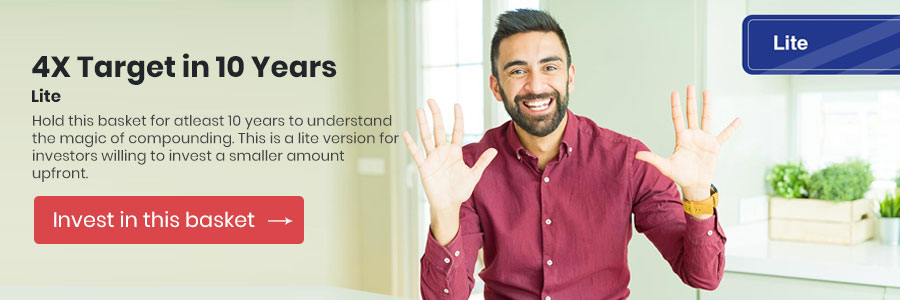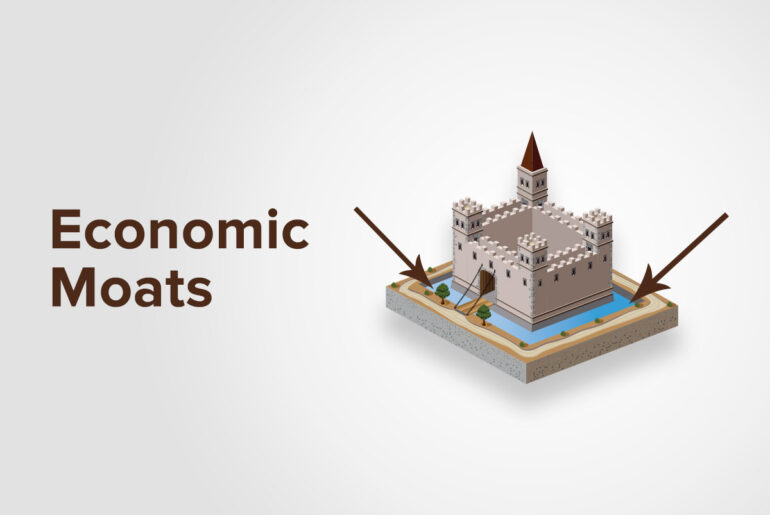Oxford dictionary defines a Moat as a deep, wide channel that was dug around a castle and filled with water to make it difficult for enemies to attack. In medieval times, all the castles had a moat to protect them from outsiders, having a moat made it extremely difficult for enemies to enter the castle.
But have you heard of an Economic Moat?
The concept of Economic moat was popularized by Warren Buffett, the concept refers to a business’ ability to gain a competitive advantage over its competitors, in order to protect its market share and long term profits from competing firms.
The strength and the sustainability of a company’s moat help us to determine the firm’s ability to prevent a competitor from taking the business away or eroding its earnings.
Consider an example of a Shopkeeper who owns a sweet shop in Mumbai. He has different varieties of sweet but the one sweet that his shop is famous for is a special type of Kaju Katri, now, in this case, we can say that the shopkeeper has this special sweet which acts as a competitive advantage for him. This competitive advantage will be with him unless some other shop sells the same sweet with the same taste. This competitive advantage has helped him to project his market share over others.
Why must investor look for economic moat in a company?
Here is a question for you – would you want to invest in a company that has a bleak future?
I am sure your answer is NO.
The main reason why we invest is to create wealth. Investors must identify companies that can generate high returns over long periods.
They must first achieve a long-term competitive advantage to sustain in this competitive world. What can make them more preferable than their competitors?

How to determine if a company has an economic moat?
Now that we understand what economic moat is, let’s discuss how to identify companies with economic moat.
Here are three best ways to identify a company’s economic moat.
1. Historical profitability
Analysing economic moat factors is more qualitative rather than quantitative. Is the firm able to generate solid returns for its shareholders?
But what if the company does not know how to use its resources efficiently to generate profits?
Hence, you must always analyse the company’s past financial record first.
Read the company’s annual report. Conduct ratio analysis. Compare their financials with their competitors.
2. Sustainability of the company
You must evaluate how long the company will be able to keep up with market competitors. You can do this by comparing the sales and profit figures of the companies.
This is also referred to as the company’s competitive advantage period. It can be as long as several decades or just a couple of months. The longer the competitive advantage period, the better is the company’s economic moat.
For example, there was a time when Vodafone enjoyed a huge share of loyal customers. They were one of the leading telecom service providers in India. But things changed when Jio, it’s competitor, entered the market. Today, Vodafone Idea is on the verge of going bankrupt.Watch this video by CA Paras Matalia where he talks about Vodafone Idea Limited and why it is where it is now.
3. Industry analysis
Does the industry have many profitable firms? Or does it consist of only a few companies that are hypercompetitive? Use Porter’s five forces to conduct an industry analysis. It also helps us identify a company’s economic moat in the simplest way possible.
The forces bring forth a company’s position amongst its competitive rivalry. The five forces include –
- Competition in the industry
- Threat of new entrants.
- Power of suppliers
- Power of customers
- Threat of substitute products
Porter’s Forces help us check the quality of a company and industry. The model is applied to understand the competition within the industry. It helps identify an industry’s barrier to entry, efficiency, scale of business, cost of capital, pricing power, cost advantages, etc.
By thoroughly analysing an industry, one can easily identify which economic moat a company holds over others.
Watch this video to understand how you can use Porter’s Five Forces to conduct industry analysis –
Four Main Types of Economic Moat
A company can have more than one economic moat. Now that you know how to analyse a company to identify their moats, let’s talk about the different types of economic moat.
Here are four example of strong economic moats a company can hold –
Low-cost supplier
Companies have a distinct competitive advantage if they can produce goods and services at a low cost.
Dmart is a great example of a low-cost provider. Their low operating cost and bargaining power allows them to sell goods to customers at cheaper prices. This makes them more preferable over others by consumers. This makes them one of the dominant players in retailing.
High switching costs
Switching costs are a one-time expense or inconvenience cost. A customer would incur such costs to switch over from one product to another.
Customers always need a very strong reason to switch services. If a company can make it tough for its customers to use a competitor’s product, it is a good sign.
The network effect
The network effect is a phenomenon where increased numbers of users, people or participants improve the value of a good or service.
For example, there are millions of people using Whatsapp, Facebook, ClubHouse, Linked In, etc.
This is one of the most influential competitive advantages. It comes into play when a company gives out a new update. The new system update or a new feature will attract new customers and will benefit the existing customers at the same time. This can be considered as a first-mover advantage
They make the company’s product and service more valuable. These products and the ideas can be copied but the network effort will prevent the existing customers from switching to another network.
Intangible assets
Intangible assets include what one can feel but not see. They don’t have a physical presence. Intangible assets give companies a competitive advantage over their competitors. This includes –
- Intellectual property rights
- Patents and trademarks
- Copyrights
- Government approvals
- Brand names
- Unique company culture
- Geographic advantage
For example, for a pharmaceutical company, intangible assets play a huge part in determining their moat. This includes trademarks, brands acquired, research and development, designs, technical know-how, licences, etc.
End Note
Economic moat helps companies keep their competitors at bay. But to be able to recognize a company’s economic moat, one must have analytical skills.
The degree of your analytical skill will help you identify which company is better than the other to invest in.
Successful long-term investing is not just about strong financial numbers. The quality of the company is equally important. Successful investing is more about identifying and investing in companies that have the ability to stand the test of time.
To identify such stocks, one needs to research various companies aggressively. At StockBasket, along with 2 crore data points, our technology evaluates and invests in stocks who are fundamentally strong and can pass a 5-years bondtest.
That means, at StockBasket, we select stocks which investors can own without losing their sleep even if the markets shut down for the next five years. We strongly believe in Buffett’s saying – ‘our favourite holding period is forever.’
Identifying economic moats is useful while evaluating a long terms investment option. It requires a little more effort than just analysing reported numbers.
This is one of many qualitative factors which you must analyse before investing. To save you from trouble, allow us to introduce you to StockBasket. At StockBasket, we curate a mini-stock portfolio to cater to your varied financial goals.
For example, here is a basket full of quality stocks of the company which are irreplaceable.Explore the Largest Irreplaceable Networks Basket. This basket allows you to invest in companies that have a large, reliable network of distributors and are virtually irreplaceable.
With StockBasket, you don’t have to worry about reviewing your portfolio every now and then. We do that for you! You can start with a small investment of just Rs 2,500 in one of our baskets.
Simply open a FREE Demat account with Samco and get free access to StockBasket!
Recommended Read:How does StockBasket work?






